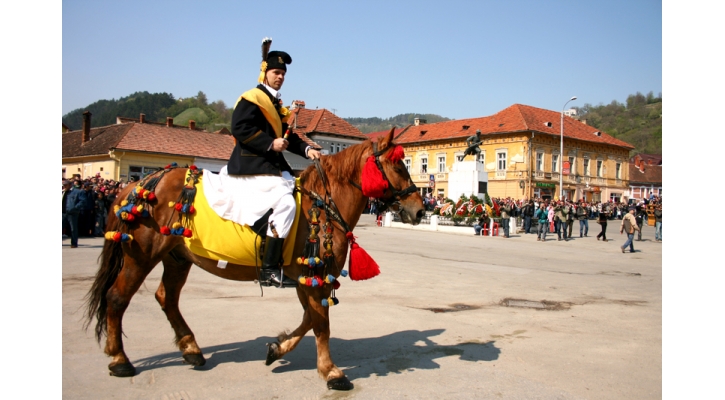Junii Braşovului
In the week following the orthodox Easter, the Young Men of Braşov or The Junii celebrate the Dacian new-year and the coming of spring.

Aruncatul junilor în ţol - The throwing of youngsters in a carpet
A week worth of celebrations of the Young Men of Braşov
The city is packed with happy Braşovians, music, markets, parades and members of The Junii performing their traditional rituals. Everything culminates in the big parade on Sunday. One of the rituals taking place during the week is the initiation of the youngest men into the first group of The Junii.
Aruncatul junilor în ţol
On Thursday, or Bright Thursday, as this day is called, a smaller ritual took place on Piaţa Unirii in the Scheii quarter of town. Here I saw the youngest men of The Junii, or soon to become, be initiated into the first group: Junii Tineri (The young unmarried men of The Junii). Aruncatul Junilor În Ţol roughly translated to English means something close to „The throwing of youngsters in a carpet”. Which is exactly what happened.
The youngest members of the Junii arrived at the square in their traditional wear, specific for their group. Now while the older groups of the Junii, wears very extravagant costumes with many different and perky colors, these young men however, wore simple black trousers and a simple black jacket. Under their knee long trousers, they wore white leggings and the only color standing out was the little red flower in their breast pocket.
The first order of the day was, of course, a small prayer around the nearby standing alter. Here they gathered around in a circle and sang and danced. Just a stepping to each side in a rhythm, sort of thing) and said their prayers before moving on to the center of the square. And here the initiation began.
Three rituals take place when the young men are initiated. A dance and a throwing of a scepter, another dance where the young men invite the young women in the crowed to participate and in the end the throwing of each member in a carpet.
The first ritual is probably the most difficult one to follow but also the simplest one. All the members gather in a half circle and here they start dancing a sort of dance.
The same series of steps performed around the alter; only this time the circle keeps moving around, which means that the audience has to keep up and follow them around as well. While they are dancing, each member takes turns throwing a scepter up in the air.
This Scepter is colored in the Romanian colors: Blue, Yellow and Red. In addition, three members of the youngsters wear a banner, colored in one of these colors, representing the flag of Romania.
The Scepter is thrown up in the air by each of the members and the higher the better! However, they also have to catch it again. After each member has had their turn, the audience is invited to try. For a small tip (which can be placed in a small bucket in the middle of the square), every viewer can try throwing the scepter.
The next ritual, the dance, happens with only some of the members, as the circle they now create is smaller and whole.
The youngsters again break out in a dance and this time young women in the audience are invited to join in. The remaining youngsters, who are not dancing, walk around the audience inviting women to join.
The last ritual is the one involving the carpet. Here all the members and as well strong men from the audience gather around the edges of a huge carpet (beautifully decorated in traditional colors of course) and a member of the youngsters lays down in the middle. After a count to three, the men together throw the young boy up into the air, sometimes quite high, and then catches him again. The higher he is thrown and the more dangerous the trick he makes while in the air, the better the show is. Originally, this ritual was performed indoors. Here the point was to throw the boys high enough that he could reach the celling of the building with his fingers.
All these rituals took place on a sunny Thursday evening in the week after Easter. Everything backed by cheery traditional music consisting of a violin, a small guitar and a flute. Everywhere around me happy Romanians took hundreds of pictures, chatted and danced along with the boys, who now officially are a part of the first group of the Junii; Junii Tineri (The young unmarried men of The Junii).
The Junii
Junii Brasovuluii, the feast or festival of Braşov, takes place every year the week after Easter and culminates in a big parade and a party on Sunday. These celebrations are unique throughout Europe. Everywhere you go this week, you will stumble across either on a ritual (maybe in the manner of a dance or a song) or fair (like the flower fair on the square), or just a happy citizen taking the opportunity to promote a charity or business causes. If you walk down the main pedestrian street in Braşov during this week, you will most likely also run into a parade or a show that advertises another smaller festival, like for example the medieval festival at the Citadel.
The Junii, or, roughly translated to English: “The young men of Braşov” are the descendants of the old, real Romanians that lived outside the gate of Kronstadt (As the old city center was once called, when Germans inhabited these parts) in the Scheii-quarter of the city. Every celebration, every ritual, every song and every dance is performed by a man (or men), whose ancestors walked among the original Romanian neighborhood outside Kronstadt’s main gate: St. Catherin’s Gate.
On the Sunday after Easter, almost the full population of the City gathers to see the parade that marks the end of a week full of celebrations. The Junii celebrates, on this day, the Dacian new-year and the beginning of spring.
The parade involves horses dressed in all kinds of colors (traditional colors of course), matching the rider and his role in the parade, each outfit marking the group to which he belongs, each group dressing more spectacular than the other.
From the young unmarried men, Junii Tineri who wear their simple black jacket with a red flower in the breast pocket to the sparkling older groups, which all wear impressive gowns of countless colors and fabrics.
Other Rituals
Through the week many other rituals take place. Not many women are included in these, but one in particular centers on the women of the community. On Monday, the members of the Junii approache the women, whom give them red dyed eggs. After each member of the Junii has received his egg, the men spray women with perfume.
Another ritual that sometimes takes place on the Bright Thursday is "Îngroparea Vătafului". This ritual has been preserved from the tribes of the Dacians, more than 2,000 years ago.
The tradition involves tying the leader of the Junii onto a ladder and then carrying him around while a priest gives the funeral rituals. In order for the leader to be let down, he has to promise a large quantity of wine to the group. Sadly, I did not get to see this ritual the Thursday I went.
The Junii and the Days of Braşov are a perfect example of the culture that still blossom in a thriving and modern city like Braşov. The fact that so many people show up to watch and support both the parade on Sunday and the initiation on Bright Thursday, only shows how important the old traditions and history are to the common Braşovian.
The Groups of the Junii
There are seven groups of the Junii because, according to Christianity, the world was created through seven days. The groups however have nothing to do with each day of the week.
Junii Tineri: The Younger Unmarried Men
Junii Batrani: The Younger Married Men
Junii Curcani: The Turkey Youth (This group’s flag holds the countenance of Mihai Viteazu, the first king who united the three Romanian.)
Junii Dorobanti: Nation of Soldiers (This group defended The Citadel from the Turks various times.)
Junii Brasovecheni: The Elder men of Braşov
Junii Rosiori: The Red Men of Braşov
Junii Albiori: The White Men of Braşov
Junii Gălbiori: The Yellow Men of Braşov
Text and photos: Johanna Engebjerg Englev






